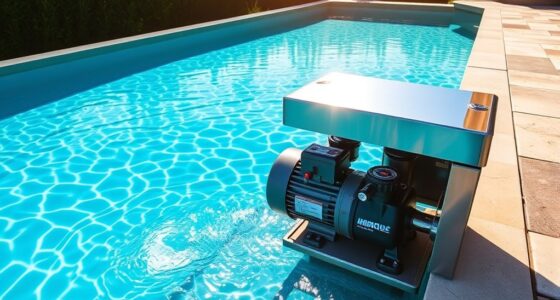If you notice cracks, chips, or significant discoloration on your infinity pool edge, it’s time to contemplate resurfacing before minor issues turn into costly repairs. Signs like water leaks, uneven or warped edges, persistent stains, or visible rust indicate the surface is deteriorating and in need of attention. Addressing these issues early helps maintain safety, appearance, and structural integrity. Continue exploring to learn more about how and when to resurface your pool edge effectively.
Key Takeaways
- Notice visible cracks, chips, or surface erosion indicating material deterioration needing resurfacing.
- Observe persistent discoloration, staining, or fading that resists cleaning or regular maintenance.
- Detect structural issues like uneven water levels, tilting edges, or shifting tiles signaling underlying damage.
- Identify corrosion, rust stains, or flaky metal components that compromise the pool edge’s integrity.
- Address surface damage early, such as cracks or chips, to prevent leaks, further deterioration, and costly repairs.
Signs of Chipped or Cracked Edges

If you have a resurfaced infinity pool edge, it’s important to keep an eye out for signs of damage. Look closely at the edges for chips, cracks, or any areas where the surface appears uneven or deteriorated. Small chips can quickly expand if left unattended, compromising the structural integrity of the edge. Cracks might start as thin lines but can widen over time, leading to potential leaks or further damage. Pay attention to loose or crumbling material, which indicates the surface is weakening. You might also notice water pooling or seeping through cracks, signaling that repairs are needed. Regular inspections help catch these issues early, preventing costly repairs and maintaining the pool’s aesthetic appeal. Additionally, surface maintenance plays a vital role in extending the lifespan of your pool’s edges and preventing future damage.
Discoloration and Fading of Surface Material
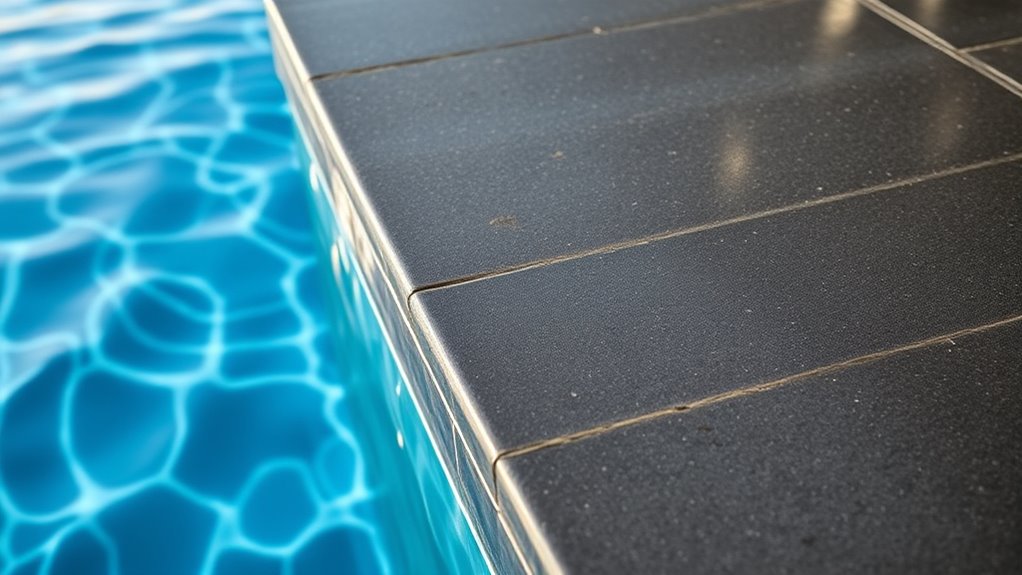
Over time, the surface of your infinity pool edge can become discolored or fade, signaling it may need attention. Sun exposure, chemical imbalance, and weather can cause these changes, making the surface look dull. Knowing when to resurface depends on spotting these signs early and understanding the underlying causes. Additionally, using specialized pool surface treatments can help protect the material and extend its lifespan.
Causes of Surface Discoloration
Surface discoloration in an infinity pool often results from exposure to environmental elements and chemical imbalances. Sun, rain, and pollutants can cause staining, while improper pH levels or chlorine imbalance lead to surface oxidation or staining. Over time, minerals in water like iron or copper can deposit, causing rusty or greenish hues. Additionally, algae or mold growth can stain surfaces if maintenance lapses. Recognizing the importance of conflict resolution skills can help address underlying issues that contribute to surface problems.
Signs of Material Fading
Materials used in infinity pool edges often show signs of fading and discoloration over time, revealing their exposure to environmental elements and regular use. You might notice the surface losing its original vibrancy, appearing dull or uneven. Color inconsistencies, such as lighter patches or streaks, indicate fading, especially in high-traffic areas or zones exposed to direct sunlight. Cracks or surface roughness can also signal material breakdown, often accompanying fading. If the surface looks worn, faded, or discolored compared to when it was installed, it’s a clear sign that the material has deteriorated. Additionally, UV exposure can accelerate the fading process, making resurfacing a more urgent consideration. These visual cues suggest that the surface’s protective qualities are diminishing, and resurfacing may be necessary to restore the pool’s aesthetic appeal and structural integrity.
Timing for Resurfacing
When you notice significant discoloration or fading on your infinity pool edge, it’s a clear sign that resurfacing should be considered soon. Fading and discoloration indicate the surface material is deteriorating and losing its protective qualities. Waiting too long can lead to further damage, such as cracks or leaks, which complicate repairs and increase costs. Ideally, you should schedule resurfacing at the first signs of surface wear, before the damage worsens. Regular inspections help catch these issues early. If fading is persistent despite cleaning, or if patches of discoloration appear uneven, it’s time to act. Resurfacing restores the pool’s aesthetic appeal and prevents future structural problems, ensuring your infinity pool remains safe, functional, and visually stunning for years to come. Additionally, using proper surface materials can extend the lifespan of your pool edge and maintain its appearance longer.
Water Leaking or Pool Edge Instability
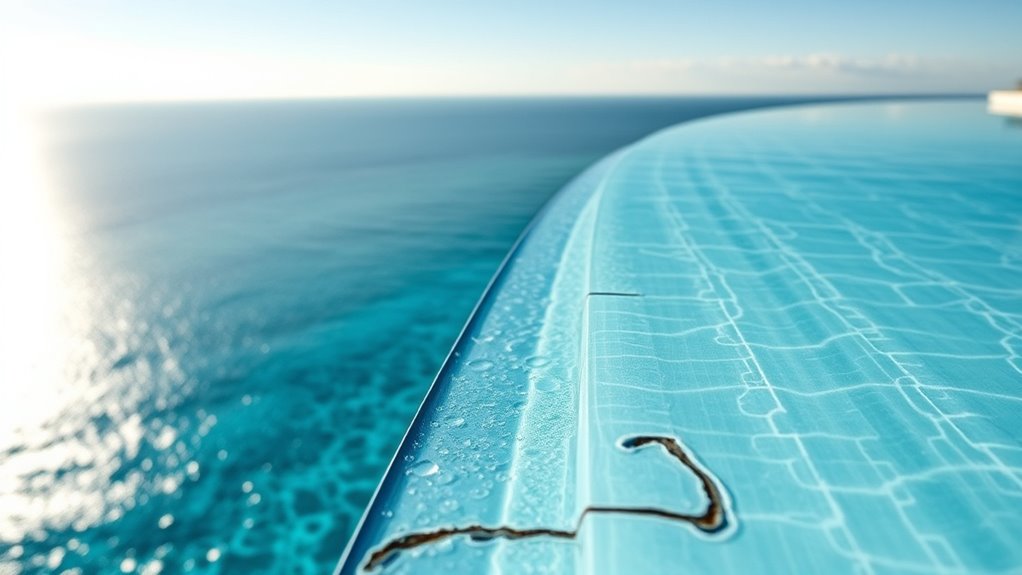
If you notice water leaking from your infinity pool edge or it feels less stable than before, addressing the issue promptly is vital. Leaks can indicate structural problems or seal failures, risking further damage. Instability might mean shifting or loose tiles, which can lead to cracks or collapse. Regularly inspect the edge for cracks, gaps, or water accumulation. To help you identify potential issues, consider this:
| Issue | Action Needed |
|---|---|
| Water leakage | Seal repairs or edge resealing needed |
| Pool edge feels unstable | Reinforcement or resurfacing required |
| Visible cracks or gaps | Immediate repair to prevent worsening |
Ignoring these signs can escalate repairs and compromise your pool’s safety. Stay proactive to maintain your infinity pool’s beauty and functionality. Waterproofing techniques can also help prevent future leaks and extend the lifespan of your pool edge.
Uneven or Warped Pool Edges
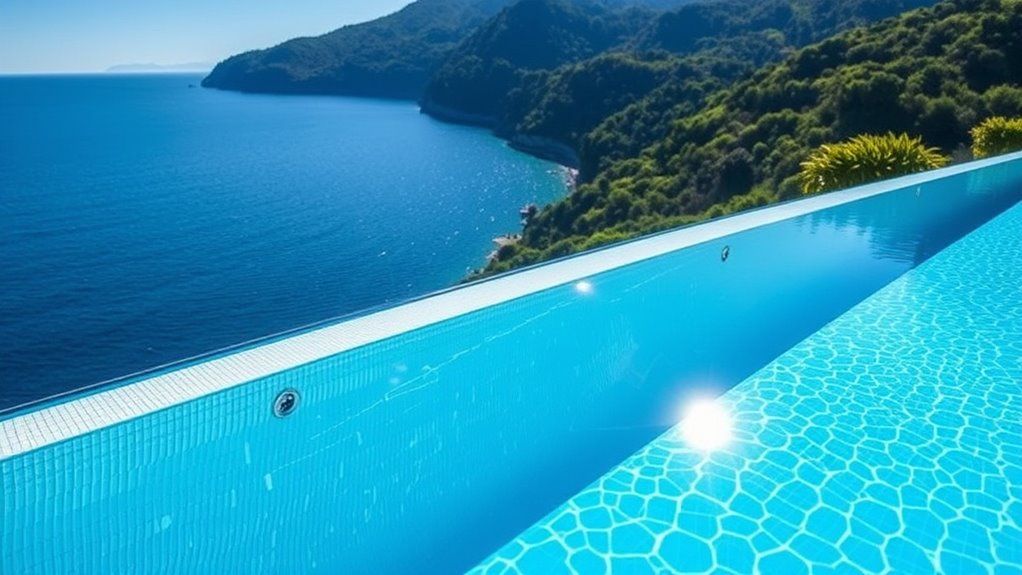
Uneven or warped pool edges can compromise both the safety and aesthetic appeal of your infinity pool. If you notice your edge isn’t level or has visible distortions, it’s time to contemplate resurfacing. An uneven surface can cause water to spill over unpredictably, creating hazards and damaging your pool’s structure. Warping may also lead to cracks or further deterioration over time. Additionally, retail hours for pool supplies and services can be helpful when scheduling repairs or maintenance. Here are key signs it’s time for action:
- Water spills over unevenly or pools in certain areas.
- Visible cracks, bulges, or warping on the edge.
- Difficulty maintaining a consistent water level or flow.
Addressing these issues promptly ensures your pool remains safe, functional, and visually stunning. Resurfacing can restore a smooth, level edge and prevent further damage.
Excessive Mold, Mildew, or Algae Growth
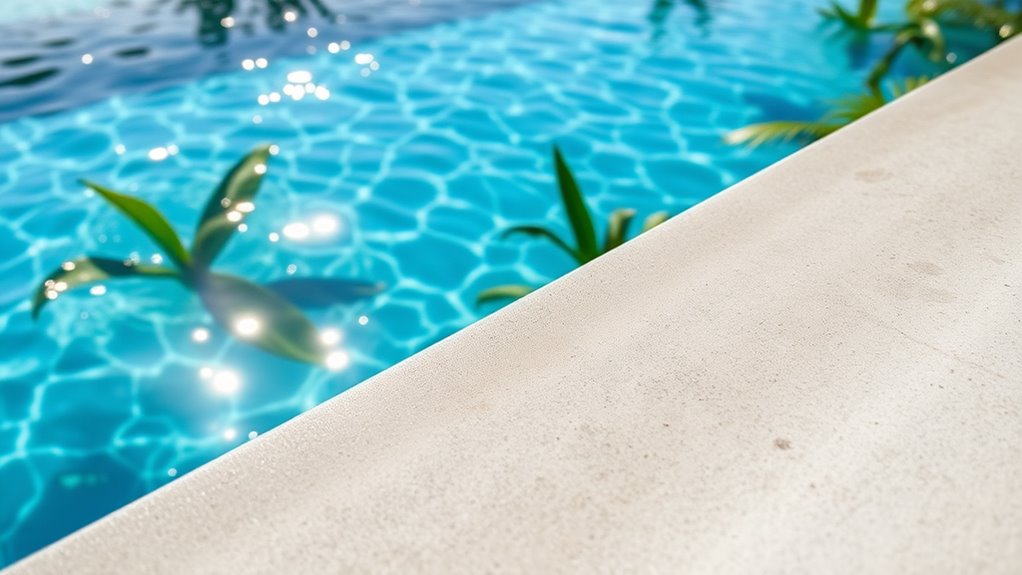
You might notice dark spots or slimy patches along your pool edge, signaling mold, mildew, or algae overgrowth. Recognizing these signs early helps avert damage and keeps your pool safe. Knowing when to clean ensures you maintain a healthy, attractive infinity edge. Additionally, regular maintenance and monitoring can prevent the spread of algae growth, ensuring your pool remains pristine and inviting.
Identifying Overgrowth Signs
Overgrowth signs such as excessive mold, mildew, or algae can quickly become visible on the edges of your infinity pool if left unchecked. Look for dark streaks or fuzzy patches that don’t wash away easily. These are clear indicators that overgrowth is occurring. You should also pay attention to a slimy or sticky film that develops on the surface, making it slippery or unappealing. Additionally, discoloration or streaks of green, black, or brown can signal algae buildup. To stay ahead, regularly inspect your pool edges for these signs. Early detection helps prevent damage to the surface and keeps your pool looking pristine. Addressing overgrowth promptly ensures your pool remains clean, safe, and visually appealing.
Timing for Cleaning
Timing is essential when it comes to cleaning mold, mildew, or algae buildup on your infinity pool edges. You should address these issues as soon as you notice them to prevent damage to the surface and maintain a pristine appearance. Regular inspections, especially after warm, humid weather or heavy rain, can help catch growth early. Waiting too long allows mold and algae to penetrate deeper into the material, making cleaning more difficult and costly. If you see dark streaks, discoloration, or slippery patches, it’s time to act. Prompt cleaning not only preserves the aesthetic appeal but also extends the lifespan of your pool edge. Stay vigilant and prioritize timely maintenance to keep your infinity pool looking luxurious and functioning correctly.
Evidence of Structural Shifts or Movement
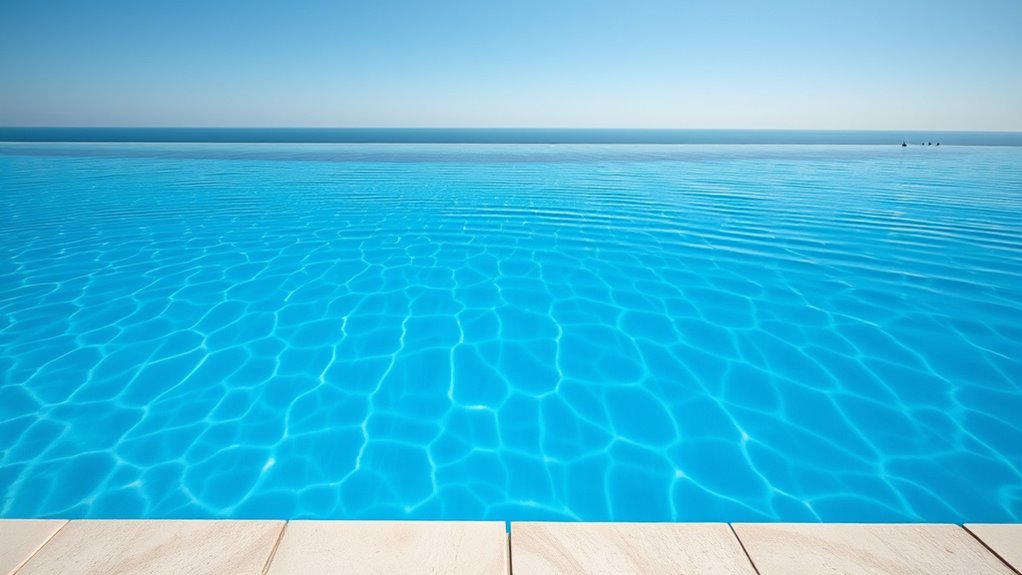
Evidence of structural shifts or movement in an infinity pool edge can often be identified through visible cracks, uneven surfaces, or misaligned tiles. These signs indicate the pool’s foundation may be shifting, which could threaten its integrity. To assess movement, look for:
- Cracks in the concrete or surrounding deck that appear wider or longer over time.
- Uneven water levels or tilting of the pool edge, suggesting shifting support.
- Misaligned or loose tiles around the edge, revealing underlying movement or settling.
- Regular inspection and maintenance can help detect subtle signs of foundation issues before they become major problems.
If you notice any of these signs, it’s a clear warning that the pool’s structure might need evaluation and possibly resurfacing. Addressing these issues early helps prevent more serious damage and ensures your pool remains safe and functional.
Visible Rust or Corrosion on Metal Components
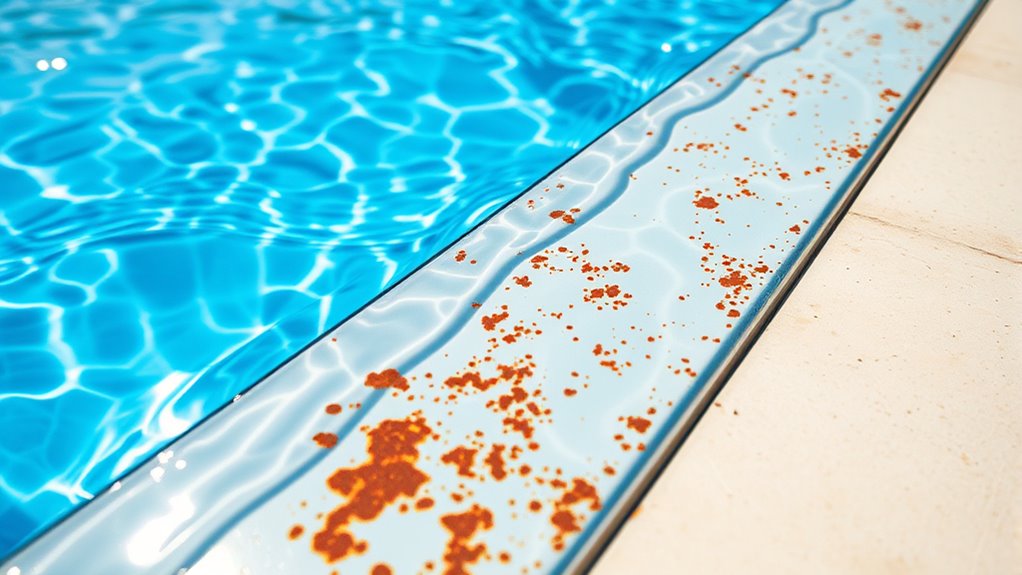
You might notice rust or corrosion on the metal parts of your pool edge, which indicates deterioration. Addressing these signs early can prevent further damage and costly repairs. Implementing corrosion prevention measures now helps protect your pool’s longevity and safety. Regular inspection and maintenance, including checking for damage or defects, can further extend the lifespan of your pool edge.
Signs of Metal Deterioration
Visible rust or corrosion on metal components is a clear sign that your infinity pool edge needs attention. When you notice discoloration, flaking, or pitting on metal parts, it indicates deterioration that could compromise structural integrity. Here are three key signs to watch for:
- Rust Stains on Surrounding Surfaces: Rust may bleed onto tiles or decking, signaling active corrosion.
- Weak or Brittle Metal: Metal components feel softer or more fragile, risking failure.
- Visible Pitting or Flaking: Corrosion creates holes or flaky patches, revealing underlying damage.
Ignoring these signs can lead to more serious issues, such as leaks or pool edge failure. Addressing corrosion early helps maintain safety, appearance, and longevity of your infinity pool.
Corrosion Prevention Measures
To prevent rust and corrosion on your infinity pool edge, implementing proactive measures is key. Regularly inspect metal components for early signs of rust or damage. Apply a high-quality, waterproof sealant designed for pool environments to protect metal surfaces from moisture exposure. Consider using corrosion-resistant materials like stainless steel or coated metals during repairs or upgrades. Keep the area well-ventilated to reduce humidity buildup, which accelerates corrosion. After pool use, rinse metal parts with fresh water to remove chlorine, salt, and other corrosive substances. Schedule routine maintenance to address minor issues before they worsen. By staying vigilant and applying these measures, you can extend the lifespan of your pool’s metal components and maintain its aesthetic appeal.
Crumbling or Eroding Surface Material
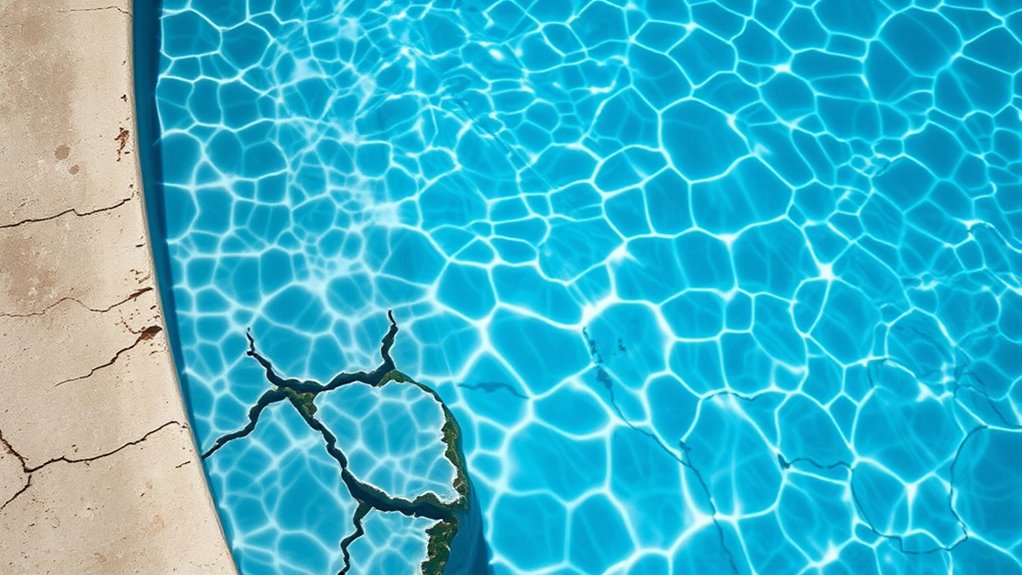
Over time, the surface material of an infinity pool edge can start to crumble or erode due to constant exposure to water, chemicals, and weather conditions. This degradation weakens the structure and can create safety hazards. You might notice small chips, cracks, or uneven patches forming along the edge. If left unaddressed, these issues worsen, leading to larger pieces breaking off or the surface deteriorating further. To prevent major repairs, pay attention to signs like surface roughness, loose fragments, or significant discoloration. Regular inspections help catch problems early. Consider these actions:
- Repair minor chips and cracks promptly to prevent expansion.
- Reapply sealants or protective coatings as needed.
- Resurface the edge if surface erosion becomes severe or unsightly.
Persistent Stains and Difficult-to-Remove Deposits
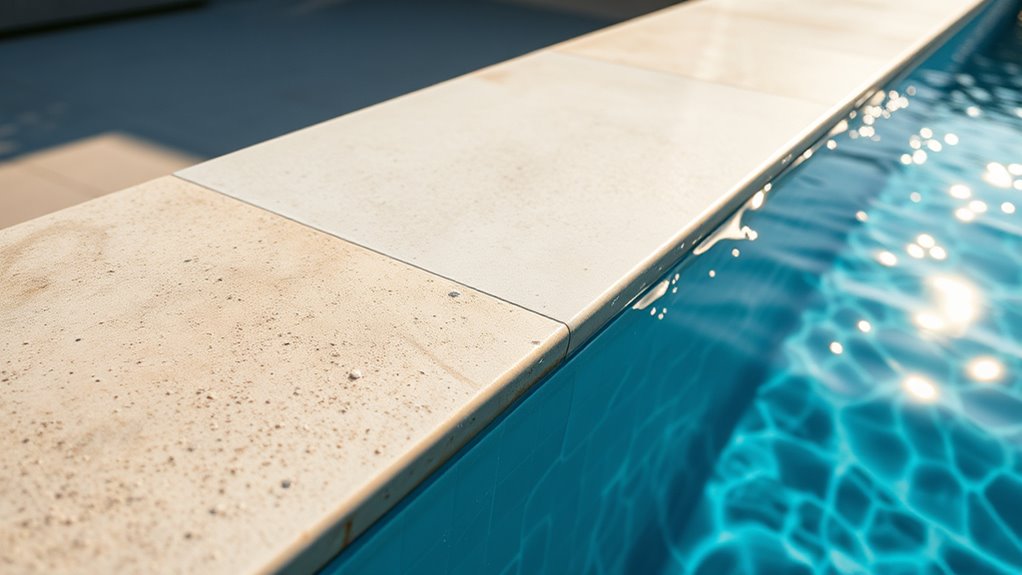
Persistent stains and deposits can be especially frustrating because they often resist regular cleaning methods. You might scrub thoroughly, but stubborn mineral deposits, algae, or hard water stains remain. These spots usually form from prolonged exposure to water minerals or environmental elements, creating a layer that standard cleaners can’t penetrate. To tackle them, you need specialized solutions like a descaling agent or a vinegar and baking soda paste. Use a soft brush or non-abrasive scrubber to gently lift the deposits without damaging the surface. Regular maintenance prevents buildup, but if stains persist despite your best efforts, it may be a sign that the pool edge needs resurfacing. Addressing these issues promptly keeps your infinity pool looking pristine and prevents long-term damage.
Changes in Water Level or Flow Patterns
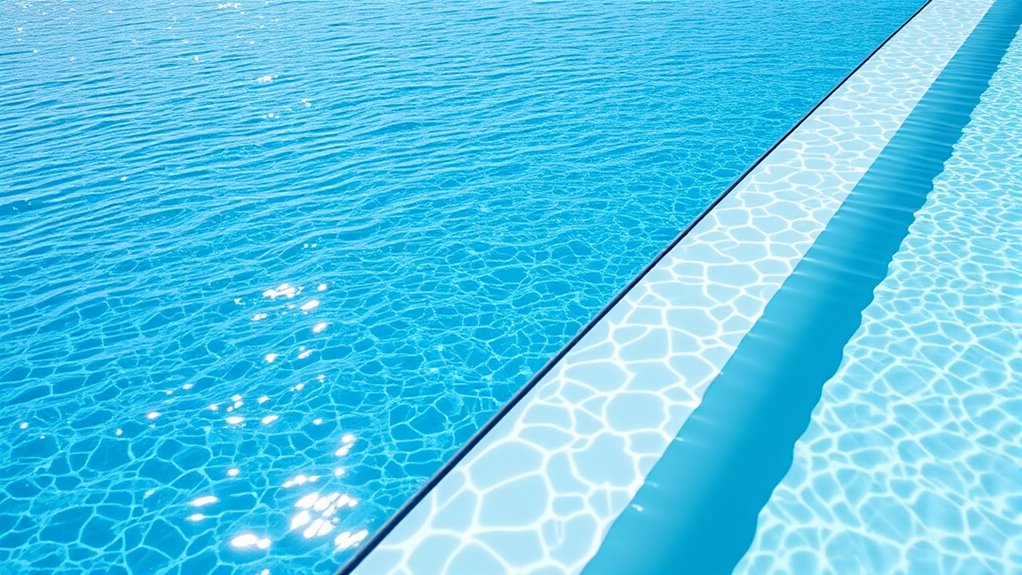
Changes in water level or flow patterns can indicate underlying issues with your infinity pool’s circulation system. If you notice the water isn’t maintaining a consistent level or the flow seems uneven, it’s a sign something’s wrong. These changes may point to a failing pump, clogged skimmer, or leaks around the edge. Addressing these issues early can prevent further damage and costly repairs.
Water level and flow changes signal circulation issues—address early to prevent costly damage.
Consider these key signs:
- Water level fluctuates unexpectedly, rising or dropping without explanation.
- Water flow appears uneven or weak in certain areas.
- The pool surface shows signs of turbulence or inconsistent movement.
Frequently Asked Questions
How Often Should I Schedule Professional Inspections for My Infinity Pool Edge?
You should schedule professional inspections for your infinity pool edge at least once a year. Regular check-ups help catch cracks, erosion, or structural issues early, preventing costly repairs and water damage. If you notice any signs of wear, such as leaks, uneven surfaces, or cracks, schedule an inspection immediately. Consistent maintenance guarantees your pool remains safe, functional, and visually stunning, extending its lifespan and preserving its elegant appearance.
What Are the Best Maintenance Practices to Prevent Surface Deterioration?
Think of your infinity pool edge as a delicate dance partner—you need to keep it in perfect step. Regularly clean the surface to remove dirt and debris, and check for cracks or chips. Apply a quality sealant annually to shield against water damage, and avoid harsh chemicals that can erode the surface. These routines help preserve its beauty and function, ensuring your pool remains a stunning and safe oasis.
Can Minor Cracks Be Repaired Without Resurfacing the Entire Edge?
Yes, minor cracks can usually be repaired without resurfacing the entire edge. You should clean the crack thoroughly, then apply a high-quality epoxy or pool-specific sealant designed for concrete or stone surfaces. Make sure to follow the manufacturer’s instructions for proper application and curing time. Regularly inspect the area, and if cracks worsen or surface deterioration occurs, consider a full resurfacing to guarantee the integrity and aesthetic of your infinity pool edge.
How Does Climate Affect the Timing of Resurfacing My Pool Edge?
Climate plays a vital role in timing your pool edge resurfacing. Warmer, humid environments accelerate wear and tear, so you should consider resurfacing sooner to prevent bigger issues. Conversely, colder, drier climates slow deterioration, giving you more time between resurfacings. You must balance these factors, monitoring for cracks, discoloration, or roughness. Proactive maintenance in response to climate conditions guarantees your infinity pool remains stunning and safe for years to come.
What Safety Precautions Should I Take During the Resurfacing Process?
During resurfacing, always wear protective gear like gloves, goggles, and a mask to prevent chemical exposure and debris inhalation. Keep the area well-ventilated, and make certain children or pets stay away from the workspace. Use caution with power tools, and follow all manufacturer instructions carefully. Have a fire extinguisher nearby, and work during daylight hours for better visibility. Prioritize safety to avoid accidents and ensure a successful resurfacing process.
Conclusion
When signs of wear appear, it’s like your pool’s edge starts whispering for renewal. Resurfacing isn’t just about repair; it’s about restoring the pool’s crown, a symbol of elegance and safety. Ignoring these signs lets cracks and stains grow like weeds, threatening its beauty and stability. Take action early—refresh your pool’s edge—and watch it shine again, a gleaming jewel in your backyard oasis, ready to welcome you with open arms.





